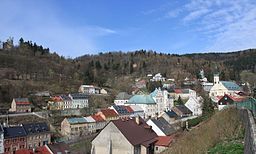Joachimsthal
| Jáchymov | ||
| Údolí Svatého Jáchyma | ||
| Town | ||
|
Jáchymov
|
||
|
||
| Country | Czech Republic | |
|---|---|---|
| Region | Karlovy Vary | |
| District | Karlovy Vary | |
| Commune | Ostrov | |
| Elevation | 672 m (2,205 ft) | |
| Coordinates | 50°21′58″N 12°55′24″E / 50.36611°N 12.92333°ECoordinates: 50°21′58″N 12°55′24″E / 50.36611°N 12.92333°E | |
| Area | 51.11 km2 (19.73 sq mi) | |
| Population | 3,481 (2006-07-03) | |
| Density | 68/km2 (176/sq mi) | |
| First mentioned | 1510 | |
| Mayor | Vondráček | |
| Timezone | CET (UTC+1) | |
| - summer (DST) | CEST (UTC+2) | |
| Postal code | 362 51 - 363 01 | |
|
Location in Karlovy Vary District
|
||
| Statistics: statnisprava.cz | ||
|
Website: www |
||
Jáchymov (Czech pronunciation: [ˈjaːxɪmof]), until 1945 known by its German name of Sankt Joachimsthal or Joachimsthal (meaning "Saint Joachim's Valley"; German: Thal, or Tal in modern orthography) is a spa town in the Karlovy Vary Region of Bohemia, now part of the Czech Republic. It is situated at an altitude of 733 m (2,405 ft) above sea level in the eponymous St. Joachim's valley in the Ore Mountains, close to the Czech border with Germany.
The town was mostly German-speaking until the end of the Second World War. In 1938, it was annexed by Germany as part of the Sudetenland. The German-speaking population was expelled in 1945 and replaced by Czech-speaking settlers.
The silver Joachimsthaler coins minted there since the 16th century became known as Thaler for short, with the word "dollar" and similar words for monetary units in many languages deriving from it.
At the beginning of the 16th century, silver was found in the area of Joachimsthal. The exploitation of this valuable resource caused the place to grow rapidly, and made the Counts von Schlick, whose possessions included the town, one of the richest noble families in Bohemia. The Schlicks had coins minted, which were called Joachimsthalers. They gave their name to the Thaler and the dollar. The fame of Joachimsthal for its ore mining and smelting works attracted the scientific attention of the doctor Georg Bauer (better known by the Latin form of his name, Georgius Agricola) in the late 1520s, who based his pioneering metallurgical studies on his observations made here.
...
Wikipedia





